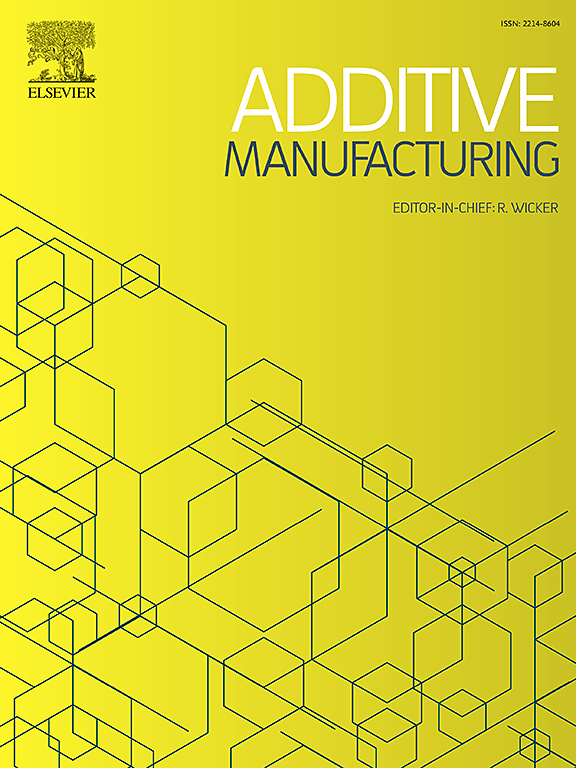探索包含无机颗粒的raft控制自由基聚合:提高陶瓷3D打印的精度
IF 10.3
1区 工程技术
Q1 ENGINEERING, MANUFACTURING
引用次数: 0
摘要
立体光刻是制造复杂陶瓷零件的一种非常有效的方法,提供快速成型速度和多种材料选择。然而,由于无机陶瓷颗粒的掺入,它仍然面临着显著的精度挑战,这改变了入射光的传播路径,并影响了聚合反应发生的区域。在此,我们通过在陶瓷立体光刻中引入可逆加成-破碎链转移(RAFT)控制的自由基聚合来调节聚合反应动力学,成功地将Al2O3光敏浆料的最小可打印特征尺寸减小到200 μm,并在所有测试的特征尺寸中获得超过86.7 %的保真度。基于raft的陶瓷立体光刻系统增强了聚合物网络的均匀性,减少了具有高折射率的高交联密度微凝胶的形成。此外,RAFT剂的加入增加了深度和宽度方向的临界能量,减轻了自由基扩散引起的靶区固化。此外,RAFT配方显著减小了宽度方向的衰减长度,拓宽了打印操作窗口,提高了尺寸稳定性。最后,在不同条件下的截面暴露分布模拟表明,RAFT-slurry减少了由于散射效应引起的固化直径展宽,增强了打印过程中的层间相互作用。本研究为精细陶瓷结构的先进制造提供了一条新的技术途径。本文章由计算机程序翻译,如有差异,请以英文原文为准。
Exploring inorganic particle-inclusive RAFT-controlled radical polymerization: Advancing precision in ceramic 3D printing
Stereolithography is a highly effective method for fabricating intricate ceramic parts, offering fast molding speeds and a diverse range of material options. However, it still faces significant precision challenges due to the incorporation of inorganic ceramic particles, which alters the propagation path of the incident light and affects the region where the polymerization reaction occurs. Herein, we regulate the polymerization reaction kinetics by introducing reversible addition-fragmentation chain transfer (RAFT) controlled radical polymerization into ceramic stereolithography, successfully reducing the minimum printable feature size of Al2O3 photosensitive slurry to 200 μm and achieving over 86.7 % fidelity across all tested feature sizes. The RAFT-based ceramic stereolithography system enhances the uniformity of the polymer network and reduces the formation of high cross-link density microgels with a high refractive index. Additionally, incorporating RAFT agents increases the critical energies in both depth and width directions, mitigating out-of-target area curing caused by radical diffusion. Furthermore, the RAFT formulation significantly reduces the attenuation length in the width direction, broadening the printing operational window and improving dimensional stability. Finally, the cross-section exposure distribution simulations under varying conditions suggest that RAFT-slurry reduces the broadening of the cure diameter caused by scattering effects and enhances inter-layer interactions during printing. This work presents a new technological approach for the advanced manufacturing of fine ceramic structures.
求助全文
通过发布文献求助,成功后即可免费获取论文全文。
去求助
来源期刊

Additive manufacturing
Materials Science-General Materials Science
CiteScore
19.80
自引率
12.70%
发文量
648
审稿时长
35 days
期刊介绍:
Additive Manufacturing stands as a peer-reviewed journal dedicated to delivering high-quality research papers and reviews in the field of additive manufacturing, serving both academia and industry leaders. The journal's objective is to recognize the innovative essence of additive manufacturing and its diverse applications, providing a comprehensive overview of current developments and future prospects.
The transformative potential of additive manufacturing technologies in product design and manufacturing is poised to disrupt traditional approaches. In response to this paradigm shift, a distinctive and comprehensive publication outlet was essential. Additive Manufacturing fulfills this need, offering a platform for engineers, materials scientists, and practitioners across academia and various industries to document and share innovations in these evolving technologies.
 求助内容:
求助内容: 应助结果提醒方式:
应助结果提醒方式:


